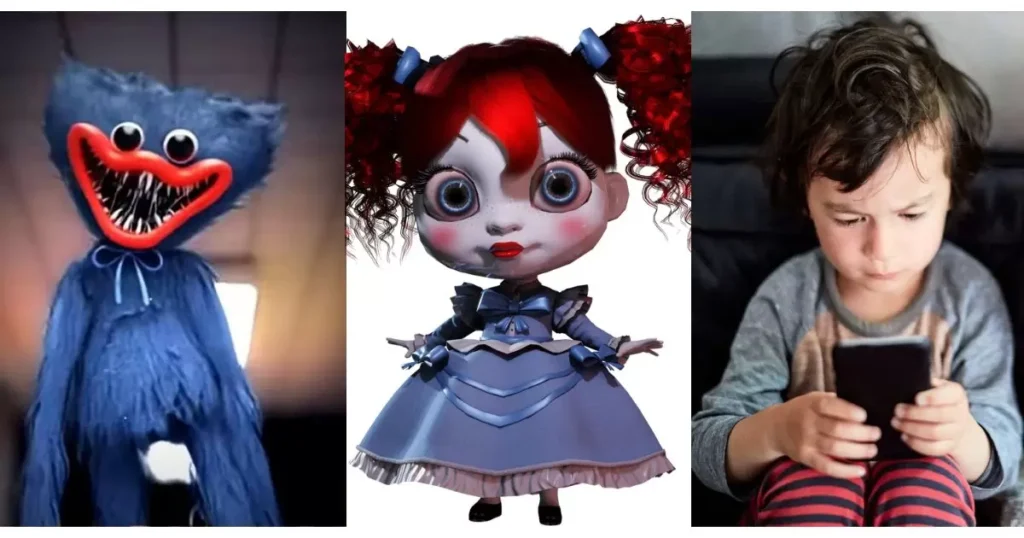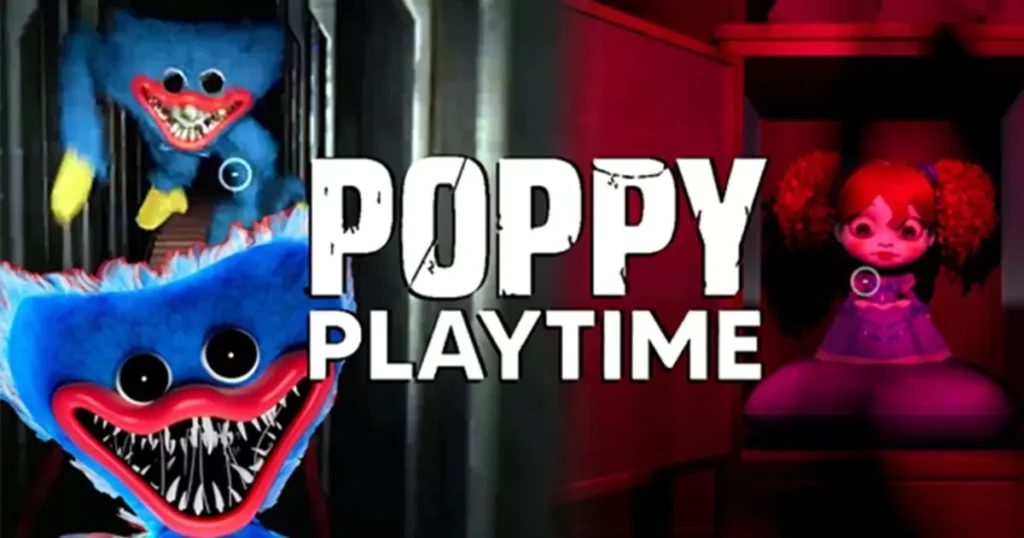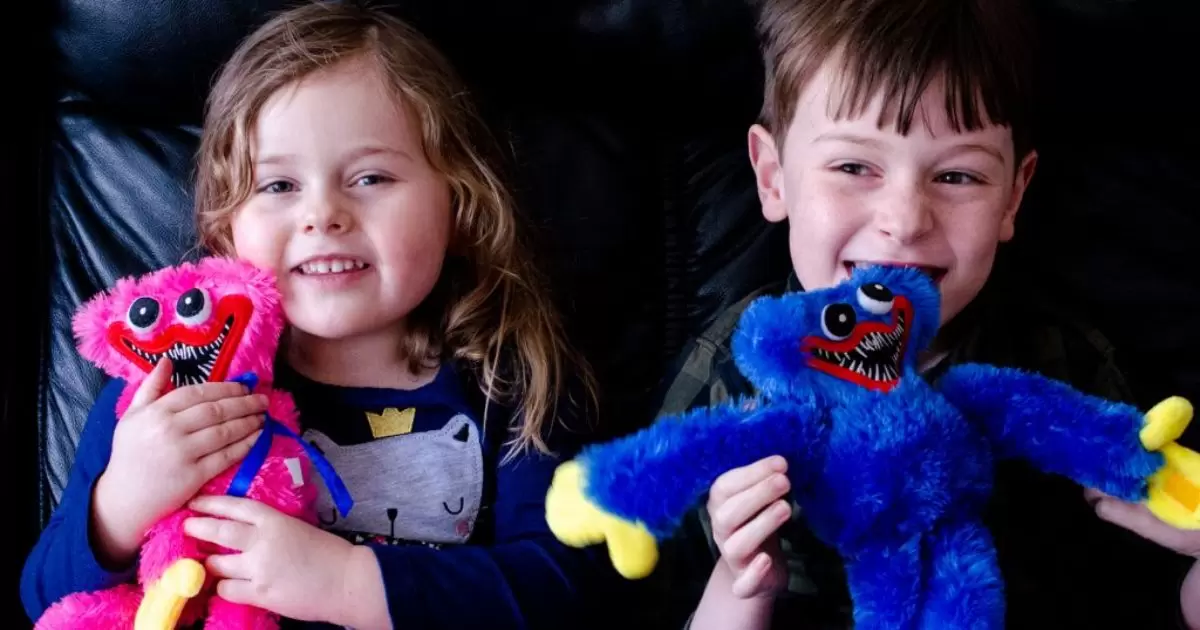The internet craze over Huggy Wuggy, a lanky blue monster character with sharp teeth from the survival video game Poppy Playtime, has raised concerns among some parents. Huggy Wuggy’s unsettling design and references to phrases like “ready or not, here I come” when chasing players have caused critics to claim the viral meme trend is inappropriate for young audiences. However, supporters counter that most children viewing the abundance of silly Huggy Wuggy songs and animated shorts likely do not understand or dwell on its origins as a horror game antagonist. As menacing as Huggy Wuggy may appear to adults, parents face a judgment call on whether to dismiss the strangeness as harmless fun or conclude the character and related content can negatively impact children’s development or sense of safety. Disagreements continue on what responsibility, if any, content creators have in considering the maturity level of new viewers brought in by a viral spread.
A little history about Poppy’s Playtime

Poppy’s Playtime exploded onto the video game scene in 2021 as a new horror game concept focusing on suspense and mystery over blood and gore. Developed by the small independent studio MOB Games, Poppy’s Playtime taps into nostalgia by taking place in an abandoned, late 1990s-style toy factory.
The player investigates various rooms of the factory and completes puzzles to unlock new areas, all while being stalked by a dark living toy named Huggy Wuggy.
I was playing Poppy’s Playtime the other day. Your Dog was sitting next to me while I played. While short in length as an independently produced game, Poppy’s Playtime garnered immediate attention for its unique graphics and refusal to follow typical horror game tropes.
By combining clues and secrets rooted in the game’s fictional history with Huggy Wuggy’s unsettling, long-limbed design pursuing the player, Poppy’s Playtime managed to build an incredibly unnerving atmosphere, often compared in intensity to the popular horror series Five Nights at Freddy’s.
This online buzz contributed to over 22 million views of Poppy’s Playtime on the gaming platform Steam within its first month of release.
Given the viral explosion in popularity across YouTube and online gaming circles, MOB Games quickly produced additional content to expand on the backstory of Poppy’s Playtime, including prequel chapters exploring what happened to the old toy factory and its employees.
The memorable and mysterious characters introduced, most notably the vicious Huggy Wuggy himself, launched an abundance of internet memes, animated shorts, and theories about what threats still lurk within the toy factory’s walls.
Poppy’s Playtime clearly resonated by striking a balance between an homage to childhood innocence and masterfully crafted moments of horror and dread lurking below the surface.
Target Audience of Poppy Playtime?

On the surface, Poppy’s Playtime seems targeted towards a younger audience given its toy store setting and cute character names like Huggy and Poppy. However, the intense horror elements and backstory surrounding the murders of employees place the game firmly in the horror genre instead.
According to many analysts, Poppy’s Playtime is for teens and mature gamers. It is a PC/Mac download rather than a kid-friendly console game; it is categorized under horror rather than family-friendly tags; online discussions refer to mature themes in the plot; and the content creator believes that viral coverage is driven by Gen Z teens obsessed with internet scares.
While some younger children have undoubtedly viewed Poppy Media online recently, they do not comprise the original core demographic based on the game’s content and distribution choices.
The 5 key bullets for Poppy’s Playtime’s target audience are:
- Original platform (PC/Mac) and genre (horror) signal mature teen/adult target
- Backstory and plot lines are inappropriate for very young viewers
- Viral popularity traced to 13-18 year old demographic
- Animated Huggy shorts viewed as “kid friendly” not representative of game itself
- Parents concerned over exposure demonstrate material in game aimed at older audience
Age Rating for Poppy Playtime
As an independently: Developed computer game lacking oversight from established industry rating systems, Poppy’s Playtime entered the market without any age or content ratings attached to it.
However, its classification as survival horror would warrant a Mature or PEGI 18 rating based on the violent themes and imagery present.
Shortly after release, Poppy’s Playtime introduced a warning that the game is meant only for ages 13 and up. Yet this self-imposed age rating has no official backing or enforcement behind it.
If subjected to review: A rating agency would likely deem Poppy’s Playtime unsuitable for those under 15-17 years old. Visual references to blood and injury, coupled with plot lines involving nightmarish living toys and employee disappearances, create a clearly horror-driven atmosphere.
While not excessively gory compared to some games in the genre, the frightening sequences and unsettling sounds still make the content inappropriate for young children.
There is also the question of whether the vibrant graphics and animated style in some ways undermine the creepy feel and make the game appeal to those below the target maturity level.
In online discussions: Mature teen gamers argue that the disturbing themes in Poppies Playtime inherently make it unsuitable for elementary age kids.
Yet the viral nature of related animated shorts and gameplay videos resulted in young children viewing content originating from an intense, horror-based game.
Parents express concern that the cute characters amidst jump scares normalize graphic content before kids are emotionally ready.
More oversight throughout the development and distribution process may have led to appropriate warning labels that could have reduced this contradiction between appearance and substance.
Creator of Huggy Wuggy song

A catchy tune called the “Huggy Wuggy Song” spread widely online. Its creator is Billie Eilish, a young musician gaining fame on the Internet. She is known for her unique style, which often mixes creepy and cute things in her songs and videos.
Billie made up and sang the Huggy Wuggy song one day when she was bored.
At the time, she had been seeing lots of memes and YouTube videos about Huggy Wuggy from the survival video game Poppy’s Playtime.
Huggy Wuggy is a tall, goofy looking stuffed blue monster with unusually long arms in the game that chases the player to try and capture them. Billie used her music skills to make up odd lyrics about wanting hugs from Huggy.
The simple song went viral almost instantly in many different versions online. Some fans redo the vocals, while others animate Huggy dancing along to the tune.
It captures how something innocent like wanting a hug combined with the weird, unnatural design of Huggy Wuggy makes him more frightening. The song added to Huggy’s fame and spread Poppy’s Playtime to new audiences.
Part of what made it so shareable is how basic and strange it is, just like Huggy himself. Billie enjoyed the randomness of her little tune, which gained so much reaction.
FAQ’s
Should parents be worried about Huggy Wuggy?
Yes, parents should be concerned about Huggy Wuggy due to the dark and violent nature of the character, which can distress young viewers.
What is the warning on Huggy Wuggy?
The warning on Huggy Wuggy states that the game is meant only for ages 13 and up.
Is Huggy Wuggy safe?
No, Huggy Wuggy is a dangerous threat in the game.
What does Huggy Wuggy do to his victims?
Huggy Wuggy attacks, catches, and presumably kills players.
Is Poppy Playtime based on a true story?
No, Poppy Playtime is fictional, not based on real events.
Conclusion
The unsettling imagery and backstory of viral internet monster Huggy Wuggy justify parents’ concerns over his potential impact on children. While silly meme songs and cartoons may appear harmless to some, Huggy’s violent behavior in the survival horror game Poppy’s Playtime makes his character inappropriate for young audiences unable to grasp the nuance.
The implications that Huggy attacks, captures, and could gruesomely kill in-game players demonstrate content that is too psychologically intense for developing minds. Although outright banning Huggy Wuggy poses challenges today, parents maintaining open discussions with older kids about balancing entertainment with psychological safety proves vital.
Establishing technology guidelines and restricting access helps enforce rating agencies’ assessments that such frightening material remains unsuitable for children. While viral favorites tend to pass quickly, public outcries to remove Huggy Wuggy indicate his image risks negatively influencing children in ways transcending “just a game”.
Reasonable worries support parents conscientiously limiting kids’ exposure to imagery that is psychologically disruptive during their formative years. Ongoing dialogue and boundaries can balance novelty and enthusiasm with responsible oversight.











